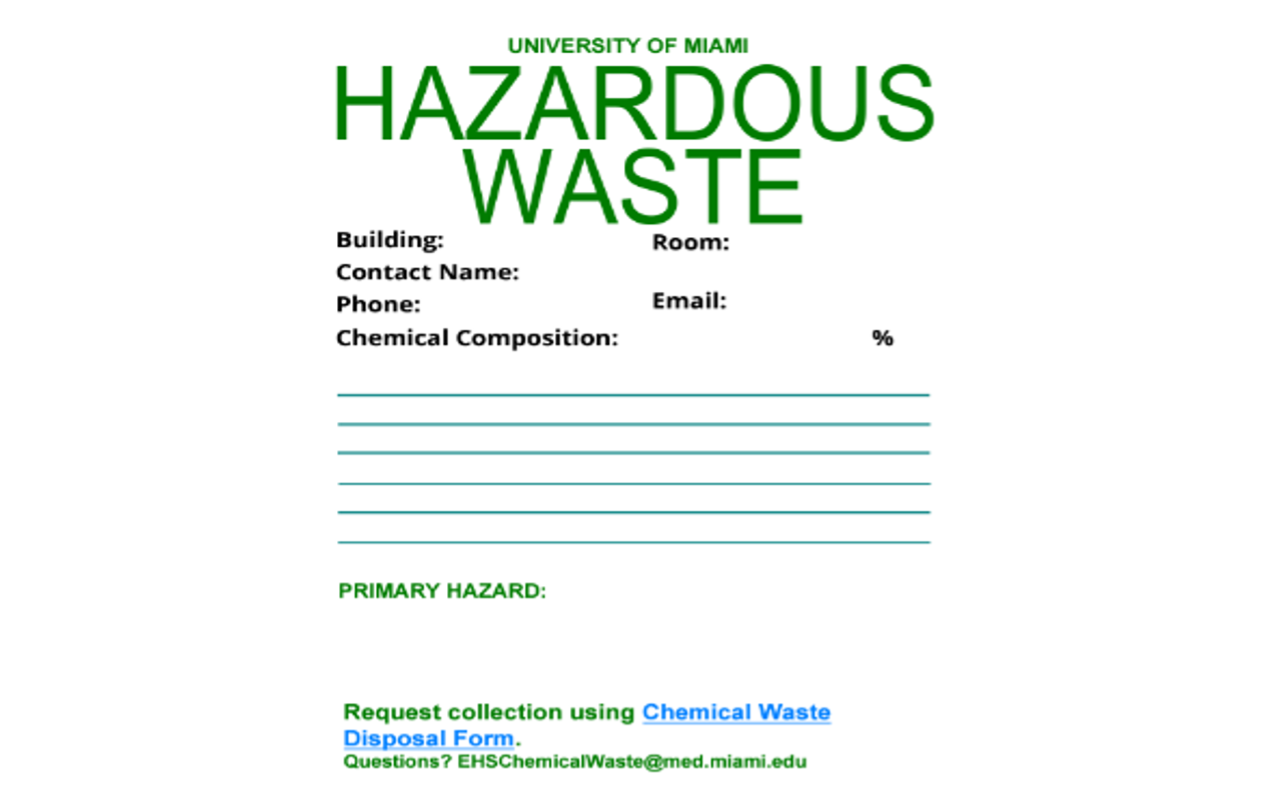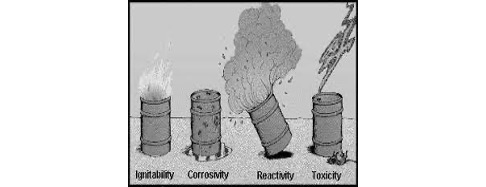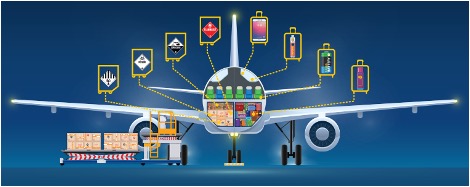Environmental Health & Safety from the Director's Desk
|
|
|
|
Our first newsletter of this year contains some great reminders on regular—and regulatory—practices that help ensure laboratory safety. Inside this helpful edition you will find some useful, quick guidance on typical laboratory practices, including shipping biological materials, labeling and containing hazardous waste, and a reminder of the new GHS pictogram system for identifying chemical hazards, followed by a key to decoding those hazards using the information on the chemical label and the safety data sheets (SDSs).
As a reminder, you can find SDSs for the University of Miami online.
Want to know how to react to a metal fire? Keep reading! Our fire safety article in this issue highlights what to use while working with flammable metals.
Lastly, keep an eye out for a special email announcement from EHS this spring. We will be hosting a few short lab safety awareness webinars. Participants will be eligible for a special prize from EHS!
Warm regards,
Jennifer Laine, DrPH
Executive Director, EHS
|
|
|
Fire Safety Tips for Using Combustible Metals/Metal Compounds
|
|
|

|
|
If you are using or have combustible metals or combustible metal compounds in your laboratory, you need a type D fire extinguisher to address fire safety. Type D extinguishers contain a dry powder that is designed for fighting fires involving combustible metals or metal alloys.
Multi-purpose (ABC) or CO2 type fire extinguisher should NOT be used on metal fires as they will adversely react with combustible metals. Likewise, do NOT use water on these types of fires.
The D fire extinguisher is recognized by its yellow color and five-pointed star on it.
The following list of combustible metals/compounds will require a D fire extinguisher:
- aluminum (powder)
- aluminum phosphide
- beryllium (powder)
- calcium
- calcium carbide
- cerium
- cesium
- gallium arsenide
- gallium phosphide
- lithium
- lithium aluminum deuteride
- lithium aluminum hydride
- lithium aluminum hydride bis(tetrahydrofuran)
- lithium amide
- lithium borohydride
- lithium-6 deuteride
- lithium hydride
- lithium tetraphenylborate tris (1,2-dimethoxyethane)
- lithium tri-tert-butoxyaluminohydride
- lutetium
- magnesium and magnesium alloys
|
- magnesium hydride
- neodymium
- nickel catalyst (Raney)
- phosphorus
- phosphorus pentasulfide
- potassium
- potassium hydride
- potassium-sodium alloys
- Red-Al
- rubidium
- sodium
- sodium aluminum hydride
- sodium bis (2-methoxyethoxy) aluminum hydride in toluene
- sodium borohydride
- sodium borohydride cobalt-doped
- sodium borohydride on alumina
- sodium hydride
- strontium
- titanium (powder)
- zinc (powder)
- zinc phosphide
- zirconium (powder)
|
Please contact Christine Daley at 305-243-8443 or c.daley@miami.edu should your laboratory require a D fire extinguisher.
|
|
|
Label Hazardous Wastes
Proper labeling of hazardous waste is an important aspect of lab safety and a cornerstone of waste management. Below is our available label that enables labs to easily and accurately identify their containers:
|
|
|

|
|
Some Key Notes
- If the waste is a solution or mixture of chemicals, the percent composition of each constituent needs to be marked.
- If your waste is hazardous, it must be additionally labeled "Hazardous Waste" and have an indication of the hazard: Flammable, Corrosive, Toxic, Reactive. The EHS has compliant labeling in the form of a fillable PDF (see picture above) that can be printed and affixed to the waste.
- If you need any assistance with determining if your waste is hazardous or with labeling, please contact the EHS Hazmat group for a consultation.
Keep Hazardous Wastes Contained
Hazardous waste containers must be closed, except when adding waste. These containers should also be in good condition, with no visible cracks or other damage. Your Satellite Accumulation Area (SAA) should be large enough to hold your hazardous waste containers, with secondary containment. Secondary containment can be simple—in general, a plastic bin large enough to contain a spill from your largest container in the area will suffice. If you have questions or need recommendations, please feel free to reach out.
As always, when you are ready for waste to be removed, please submit a signed Chemical Waste Disposal Form to EHSChemicalWaste@med.miami.edu for disposal.
|
|
|

|
What You Need to Know Before You Ship Any Dangerous Goods or Biological Materials
Non-compliance with shipping regulations can result in harsh consequences, such as exorbitant fines and possible criminal charges. Several universities have incurred sanctions for breaching federal shipping rules, which are very rigorous and essential. The good news is that these failures can be easily prevented with proper training and guidance.
To ship any hazardous agent or biological specimen from the University, you must complete the two EHS Biosafety shipping courses: Shipping of Dangerous Goods and Shipping of Biological Materials. DOT regulations require that both the sample preparer and their managers/supervisors take these courses. Therefore, we expect all lab PIs to do both courses and we recommend that entire labs do the same. This policy may appear excessive, but it is necessary to avoid serious issues from improper shipping.
Shipping of Dangerous Goods must be completed once every two years to comply with DOT regulations. Both courses must be completed on Blackboard.
Shipping of Biological Materials is delivered via webinar, with the quiz completed on Blackboard after the session. We customize these slides for each webinar to clarify how to ship your materials. Unless your shipping needs change, this training is only required once.
To clear up some confusion, the only way to satisfy DOT regulations is to complete the two trainings mentioned above. Other training courses that cover IATA regulations are not enough by themselves and are only meant to complement the main training courses. It also makes no difference if you are the person purchasing the airway bill or getting it from someone else, or if you have a kit with all the necessary labels for the package. The training is mandatory by law and all labs that ship these materials must complete them.
Another thing to remember is that if you are transporting samples from one campus to another, you need to complete these trainings as well. This way, you will know how to follow the DOT rules and the University guidelines for handling these materials.
If there are any questions on these requirements, please contact us at biosafety@miami.edu.
|
|
|

|
Globally Harmonized System of Classification and Labeling of Chemicals (GHS)
The Globally Harmonized System of Classification and Labeling of Chemicals, or GHS, is an international consensus standard that's managed by the United Nations. Development of the GHS began in 1992, and was fully implemented six years later. Before the GHS, it was difficult to obtain consistent chemical data due to the number of sources from various countries, sometimes at odds with each other, and published in different languages.
With the implementation of GHS, the information in SDSs (previously known as material safety data sheets [MSDS]), became more reliable, consistent, and organized. The information is grouped into 16 sections for quick review of the information you may need. In the United States, employers are required to make this information available to all employees who either work with or near chemical substances that can be harmful to their health.
In 2015, the GHS pictograms became a requirement on labels. These nine pictograms are designed to be immediately recognizable to anyone handling hazardous material. Being able to recognize them on chemical labels, SDSs or other containers can go a long way to keep you and others safe. As the old axiom says, "a picture is worth a thousand words."
Below you will find the OSHA quick card with the nine pictograms and their descriptions:
|
|
|

|
Signal Word, Hazard, and Precautionary Statements
Understanding what a hazardous chemical's label conveys is crucial. It helps us to quickly recognize the dangers of the chemicals and the appropriate precautions to take to protect ourselves and others. It can also encourage us to read the SDS for more details about the hazards, identity, properties, risks, and safe handling of the chemical. The OSHA Hazard Communication Standard, 29 CFR 1910.1200 Subpart Z, requires that labels on all primary containers of hazardous chemicals must include the following information: a signal word, a hazard statement, and a precautionary statement for each hazard class and category to enhance user comprehension:
- Signal word: The signal word indicates the hazard level. "Danger" is used for the more severe hazards, and "Warning" is used for the less severe hazards. There will only be one signal word on the label or on the SDS, irrespective of how many hazards a chemical may have.
- Hazards statements: Hazard statements are standardized phrases that describe the nature of the hazard(s) of a chemical, including, where appropriate, the degree of hazard. Hazard statements may be combined, where appropriate, to reduce redundancies and improve readability. The hazard statements are specific to the hazard classification categories, and users should always see the same statement for the same hazards no matter what the chemical is or who produces it. In the SDS, hazard statements are identified by an H-Code—a unique alphanumerical code that consists of one letter and three numbers. Here is an example:
- H301: Toxic if swallowed – H indicates a hazard, the 3 indicates a health hazard, and 01 is part of the sequential numbering system.
- Precautionary statements: Precautionary statements are standardized phrases that describe recommended measures that should be taken when handling or using hazardous chemicals. They are identified by a P-Code—a unique alphanumeric code that consists of one letter and three numbers. P stands for "Precautionary Statement," and xx is a sequential numbering system. Here is an example:
- P101: If medical advice is needed, have product container or label at hand – P indicates a precautionary statement, the 1 indicates it is a general precautionary statement, and 01 is part of the sequential numbering system.
In most cases, the precautionary statements are independent. However, OSHA does allow flexibility for applying precautionary statements to the label, such as combining statements, using an order of precedence, or eliminating an inappropriate statement.
Should you need more guidance on what your hazardous labels mean, please contact Adrian Hernandez Ferrer at arh38@med.miami.edu.
|
|
|
|